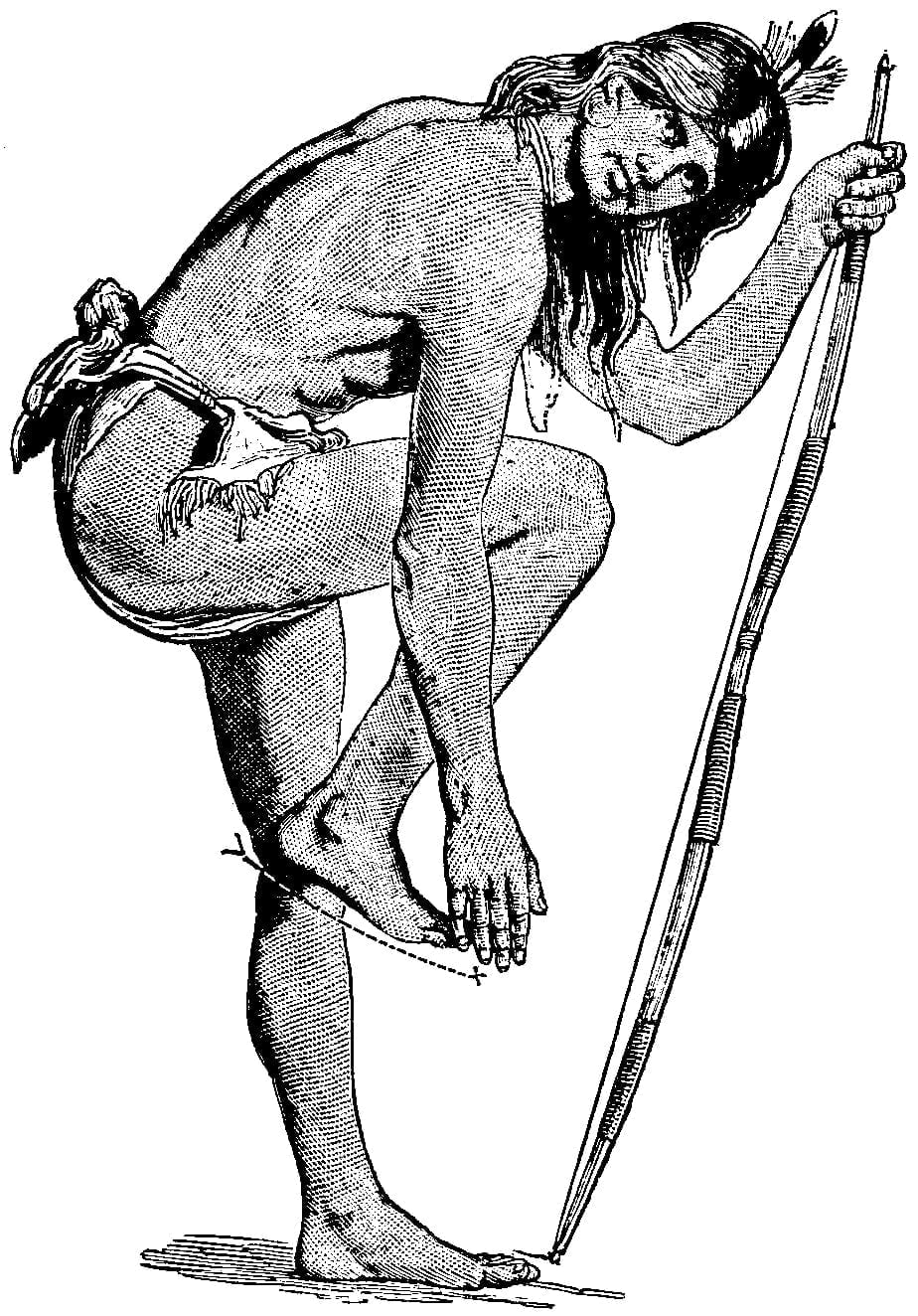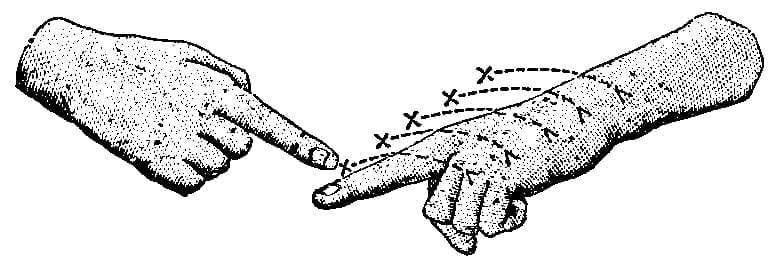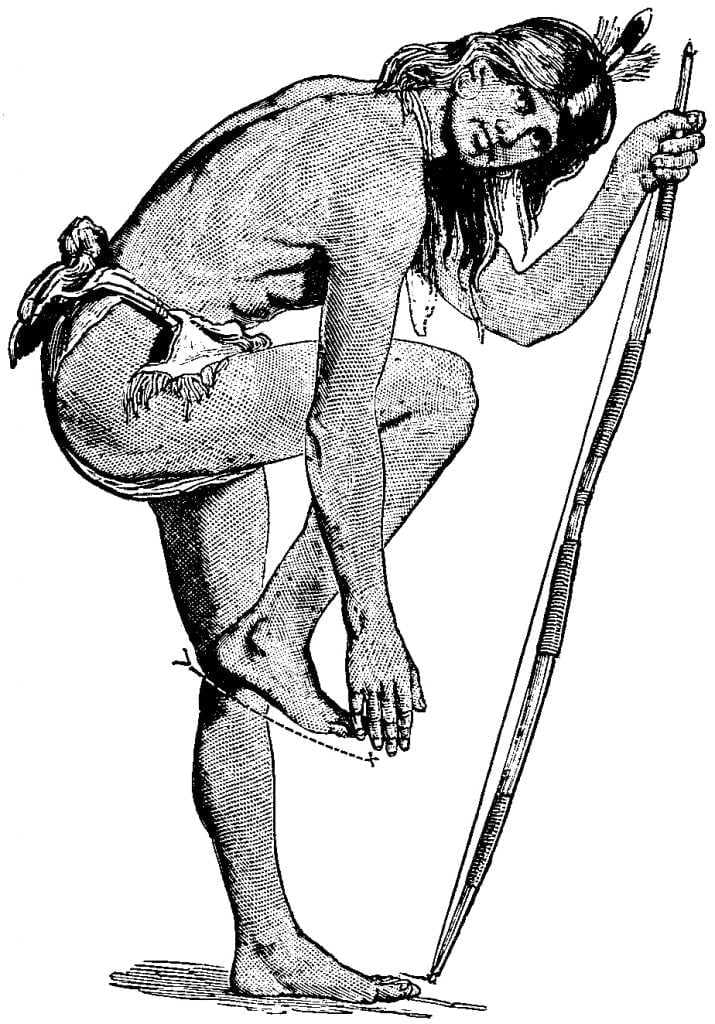Atsina, Lower Gros Ventre
Both hands closed, the tips of the fingers pointing toward the wrist and resting upon the base of the joint, the thumbs lying upon, and extending over the middle joint of the forefingers; hold the left before the chest, pointing forward, palm up, placing the right, with palm down, just back of the left, and move as if picking small objects from the left with the tip of the right thumb. (Absaroka I; Shoshoni and Banak I.) “Corn-shellers.”
Bring the extended and separated fingers and thumb loosely to a point, flexed at the metacarpal joints; point them toward the left clavicle, and imitate a dotting motion as if tattooing the skin. (Kaiowa I; Comanche III; Apache II; Wichita II.) “They used to tattoo themselves, and live in the country south of the Dakotas.”
See also the sign of (Dakota I) under Assinaboin.
Banak
Make a whistling sound “phew” (beginning at a high note and ending about an octave lower); then draw the extended index across the throat from the left to the right and out to nearly at arm’s length. They used to cut the throats of their prisoners. (Pai-Ute I.)
Major Haworth states that the Banaks make the following sign for themselves: Brush the flat right hand backward over the forehead as if forcing back the hair. This represents the manner of wearing the tuft of hair backward from the forehead. According to this informant, the Shoshoni use the same sign for Banak as for themselves.
Blackfeet (This title refers to the Algonkian Blackfeet, properly called Satsika. For the Dakota Blackfeet, or Sihasapa, see under head of Dakota)
The finger and thumb encircle the ankle. (Long.)
Pass the right hand, bent spoon-fashion, from the heel to the little toe of the right foot. (Burton.)
The palmar surfaces of the extended fore and second fingers of the right hand (others closed) are rubbed along the leg just above the ankle. This would not seem to be clear, but these Indians do not make any sign indicating black in connection with the above. The sign does not, however, interfere with any other sign as made by the Sioux. (Creel; Dakota I.) “Black feet.”
Pass the flat hand over the outer edge of the right foot from the heel to beyond the toe, as if brushing off dust. (Dakota V, VII, VIII.) Fig. 286.

Touch the right foot with the right hand. (Kutine I.)
Close the right hand, thumb resting over the second joint of the forefinger, palm toward the face, and rotate over the cheek, though an inch or two from it. (Shoshoni and Banak I.) “From manner of painting the cheeks.” Fig. 287.

Caddo
Pass the horizontally extended index from right to left under the nose. (Arapaho II; Cheyenne V; Kaiowa I; Comanche I, II, III; Apache II; Wichita I, II.) “‘Pierced noses,’ from former custom of perforating the septum for the reception of rings.” Fig. 288. This sign is also used for the Sahaptin. For some remarks see page 345.

Calispel, See Pend d’Oreille.
Cheyenne
Draw the hand across the arm, to imitate cutting it with a knife. (Marcy in Prairie Traveller, loc. cit., p. 215.)
Draw the lower edge of the right hand across the left arm as if gashing it with a knife. (Burton.)
With the index-finger of the right hand proceed as if cutting the left arm in different places with a sawing motion from the wrist upward, to represent the cuts or burns on the arms of that nation. (Long.)
Bridge palm of left hand with index-finger of right. (Macgowan.)
Draw the extended right hand, fingers joined, across the left wrist as if cutting it. (Arapaho I.)
Pass the ulnar side of the extended index repeatedly across the extended finger and back of the left hand. Frequently, however, the index is drawn across the wrist or forearm. (Arapaho II; Cheyenne V; Ponka II; Pani I.) Fig. 289. See p. 345 for remarks.

The extended index, palm upward, is drawn across the forefinger of the left hand (palm inward), several times, left hand stationary, right hand is drawn toward the body until the index is drawn clear off; then repeat. Some Cheyennes believe this to have reference to the former custom of cutting the arm as offerings to spirits, while others think it refers to a more ancient custom of cutting off the enemy’s fingers for necklaces. (Cheyenne II.)
Place the extended index at the right side of the nose, where it joins the face, the tip reaching as high, as the forehead, and close to the inner corner of the eye. This position makes the thumb of the right hand rest upon the chin, while the index is perpendicular. (Sac, Fox, and Kickapoo I.) It is considered that this sign, though given to the collaborator as expressed, was an error. It applies to the Southern Arapahos. Lieutenant Creel states the last remark to be correct, the gesture having reference to the Southern bands.
As though sawing through the left forearm at its middle with the edge of the right held back outward, thumb upward. Sign made at the left side of the body. (Dakota I.) “Same sign as for a saw. The Cheyenne Indians are known to the Sioux by the name of ‘The Saws.'”
Right-hand fingers and thumb extended and joined (as in S), outer edge downward, and drawn sharply across the other fingers and forearm as if cutting with a knife. (Dakota, III.)
Draw the extended right index or the ulnar (inner) edge of the open right hand several times across the base of the extended left index, or across the left forearm at different heights from left to right. This sign is also made by the Arapahos. (Dakota IV.) “Because their arms are marked with scars from cuts which they make as offerings to spirits.”
Draw the extended index several times across the extended forefinger from the tip toward the palm, the latter pointing forward and slightly toward the right. From the custom of striping arms transversely with colors. (Kaiowa I; Comanche II, III; Apache II; Ute I; Wichita II.)
Another: Make the sign for Dog, viz: Close the right hand, leaving the index and second fingers only extended and joined, hold it forward from and lower than the hip and draw it backward, the course following the outline of a dog’s form from head to tail; then add the sign To Eat, as follows: Collect the thumb, index, and second fingers to a point, hold them above and in front of the mouth and make a repeated dotting motion toward the mouth. This sign is generally used, but the other and more common one is also employed, especially so with individuals not fully conversant with the sign language as employed by the Comanches, &c. (Kaiowa I; Comanche III; Apache II; Wichita II.) “Dog-eaters.”
Draw the extended index across the back of the left hand and arm as if cutting it. The index does not touch the arm as in signs given for the same tribe by other Indians, but is held at least four or five inches from it. (Shoshoni and Banak I.)
Chipeway, See Ojibwa
Comanche
Imitate, by the waving of the hand or forefinger, the forward crawling motion of a snake. (Burton, also Blackmore in introduction to Dodge’s Plains of the Great West. New York, 1877, p. xxv.) The same sign is used for the Shoshoni, more commonly called “Snake”, Indians, who as well as the Comanches belong to the Shoshonian linguistic family. “The silent stealth of the tribe.” (Dodge; Marcy in Thirty Years of Army Life on the Border. New York, 1866, p. 33.) Rev. A.J. Holt remarks, however, that among the Comanches themselves the conception of this sign is the trailing of a rope, or lariat. This refers probably to their well-known horsemanship.
Motion of a snake. (Macgowan.)
Hold the elbow of the right arm near the right side, but not touching it; extend the forearm and hand, palm inward, fingers joined on a level with the elbow, then with a shoulder movement draw the forearm and hand back until the points of the fingers are behind the body; at the same time that the hand is thus being moved back, turn it right and left several times. (Creel; Sac, Fox, and Kickapoo I.) “Snake in the grass. A snake drawing itself back in the grass instead of crossing the road in front of you.”
Another: The sign by and for the Comanches themselves is made by holding both hands and arms upward from the elbow, both palms inward, and passing both hands with their backs upward along the lower end of the hair to indicate long hair, as they never cut it. (Sac, Fox, and Kickapoo I.)
Right hand horizontal, flat, palm downward (W), advanced to the front by a motion to represent the crawling of a snake. (Dakota III.)
Extend the closed right hand to the front and left; extend the index, palm down, and rotate from side to side while drawing it back to the right hip. (Arapaho II; Cheyenne V; Dakota VI, VII, VIII; Ponka II; Kaiowa I; Pani I; Comanche III; Apache II; Wichita II.) This motion is just the reverse of the sign for Shoshoni, see Fig. 297 infra.
Make the reverse gesture for Shoshoni, i.e., begin away from the body, drawing the hand back to the side of the right hip while rotating it. (Comanche II.)


